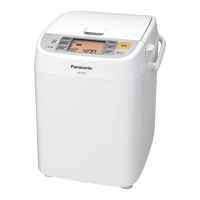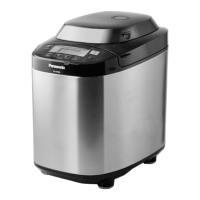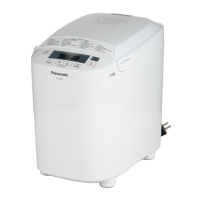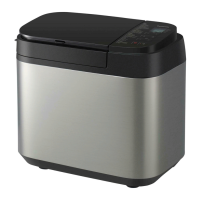GB3
Bread-making Ingredients
Bread Ingredients
It is extremely important to use the correct measure of ingredients for best results.
Liquid ingredients
Use the measuring cup or measuring spoon provided.
If the recipes indicate a mixture (the liquid plus egg), should be weighed on scales. Using digital scale is recommended.
Dry ingredients
Should be weighed on scales or measured with measuring spoon provided for the small amounts. Using digital scale is recommended.
You can make your bread taste better by adding
other ingredients.
n
Eggs
Improve the nutritional value and colouring of the bread. (Water
amount must be reduced proportionally.) Beat eggs when
adding eggs. Do not use the timer for the recipe with egg.
(Eggs go rotten quickly if your room temperature is high.)
Flour
Main ingredient of bread. The protein in flour forms gluten during kneading.
Gluten provides structure and texture and helps the bread to rise.
Use strong flour. Strong flour is milled from the wheat and has a high
content of protein which is necessary for the development of gluten.
Carbon dioxide produced during fermentation is trapped within the elastic
network of gluten, thus making the dough rise.
White flour
Made by grinding wheat kernel, excluding bran and germ. The best kind
of flour for baking bread is a flour marked “for bread baking”.
Do not use plain or self-raising flour as a substitute for bread flour.
Whole meal flour
Made by grinding entire wheat kernel, including bran and germ.
Makes very health-giving bread. This bread is lower in height and
heavier than bread baked with white flour.
Dry yeast
Enable the bread to rise.
Be sure to use dry yeast that does not require pre - fermentation. Do not
use yeast that requires preliminary fermentation. Dry yeast which has “Easy
blend”, “Fast Action” or “Easy Bake” written on the packet is recommended.
When using dry yeast from sachets, seal the sachet again immediately
after use. To store, follow the Manufacturer's instructions and discard after
48 hours of opening. It is recommended on most yeast packets to keep in a
cool dry place.
Dairy products
Add flavour and nutritional value.
●
If you use milk instead of water, the nutritional value of the bread will be
higher, but do not use in timer setting as it may not keep fresh overnight.
→Reduce the amount of water proportionally to the amount of milk.
Sugar
(granulated sugar, brown sugar, honey, treacle, etc.)
Food for the dry yeast, sweetens and adds flavour to the bread, changes
the colour of the crust.
●
Use less sugar if using raisins or other fruits, which contain fructose.
Water
Use normal tap water.
When room temperature is low, use tepid water for menu 2, 5, 8, 10.
When room temperature is high, use chilled water for menu 6 or 7.
Always measure out liquids using the measuring cup provided.
Salt
Improve the flavour and strengthen gluten to help the bread
rise. The bread may lose size / flavour if measuring is
inaccurate.
Fat
Add flavour and softness to the bread.
Use butter (unsalted), margarine or oil.

